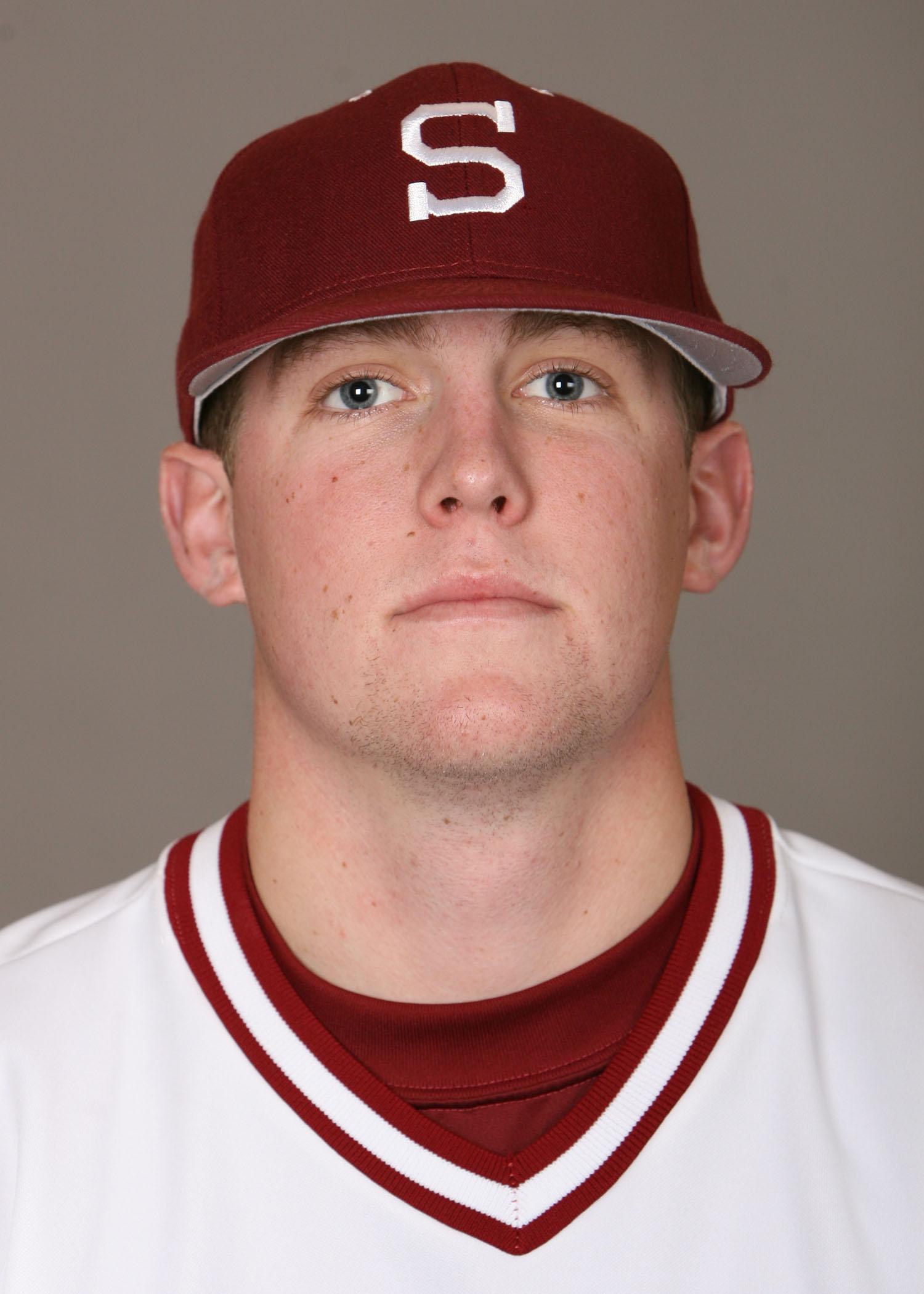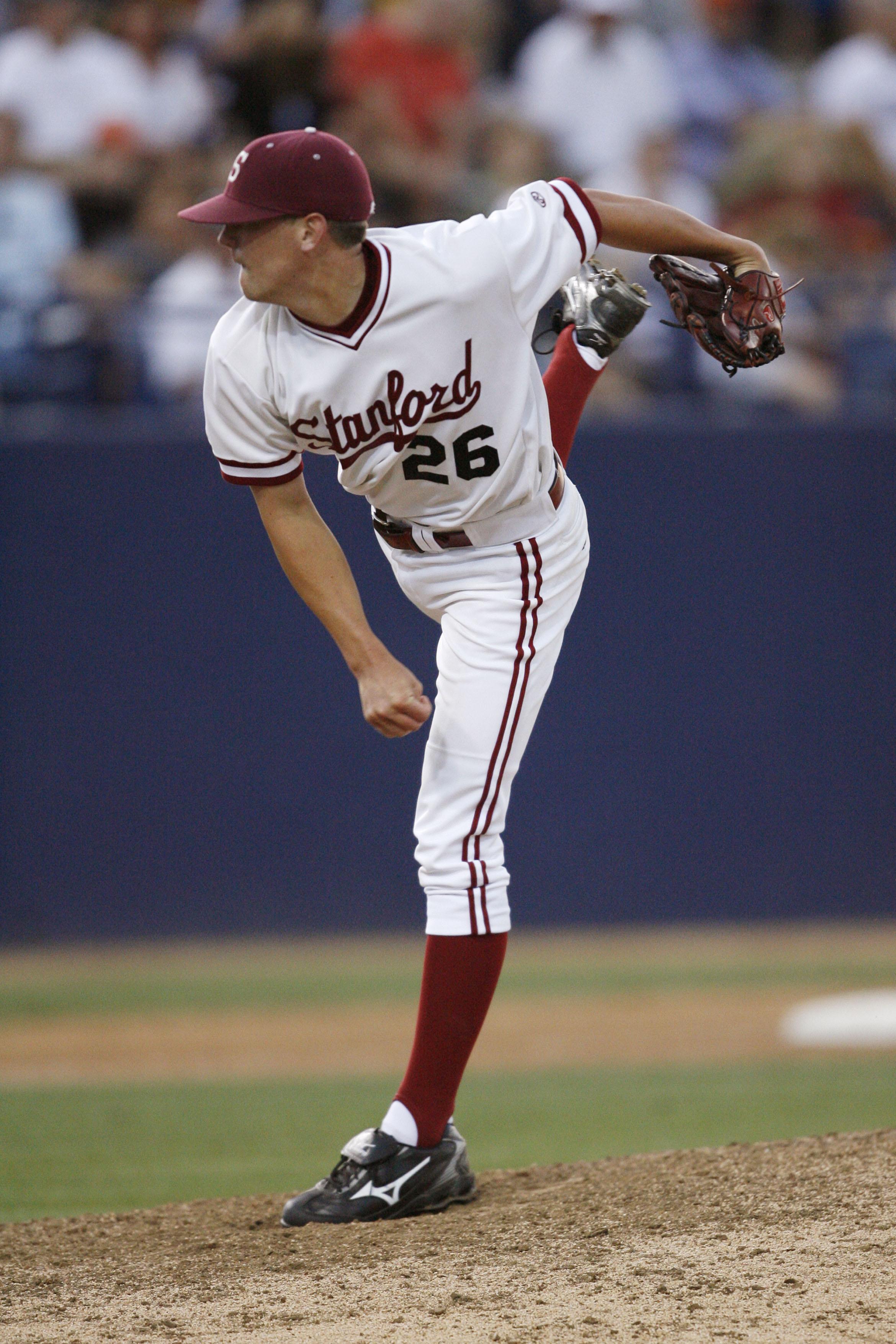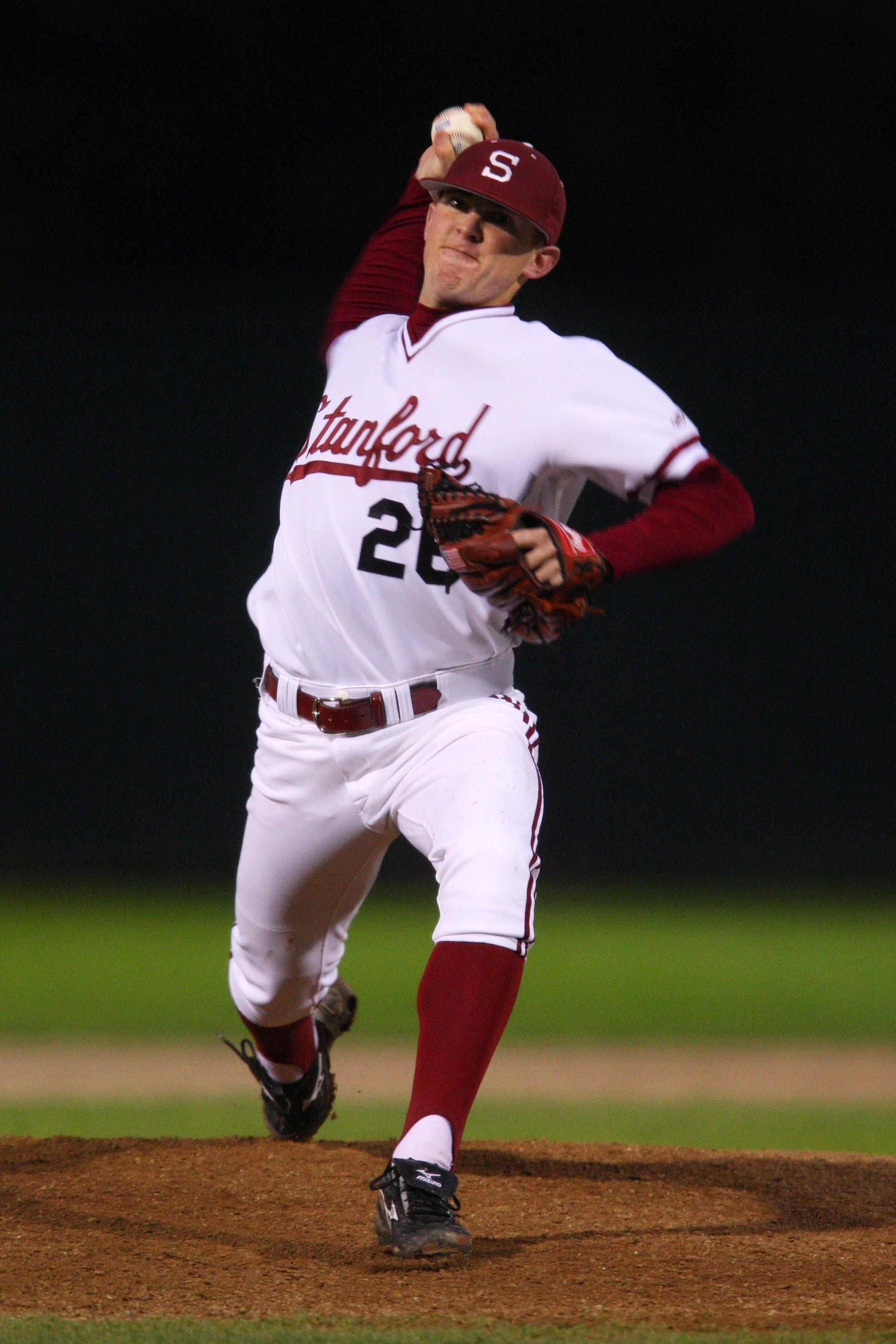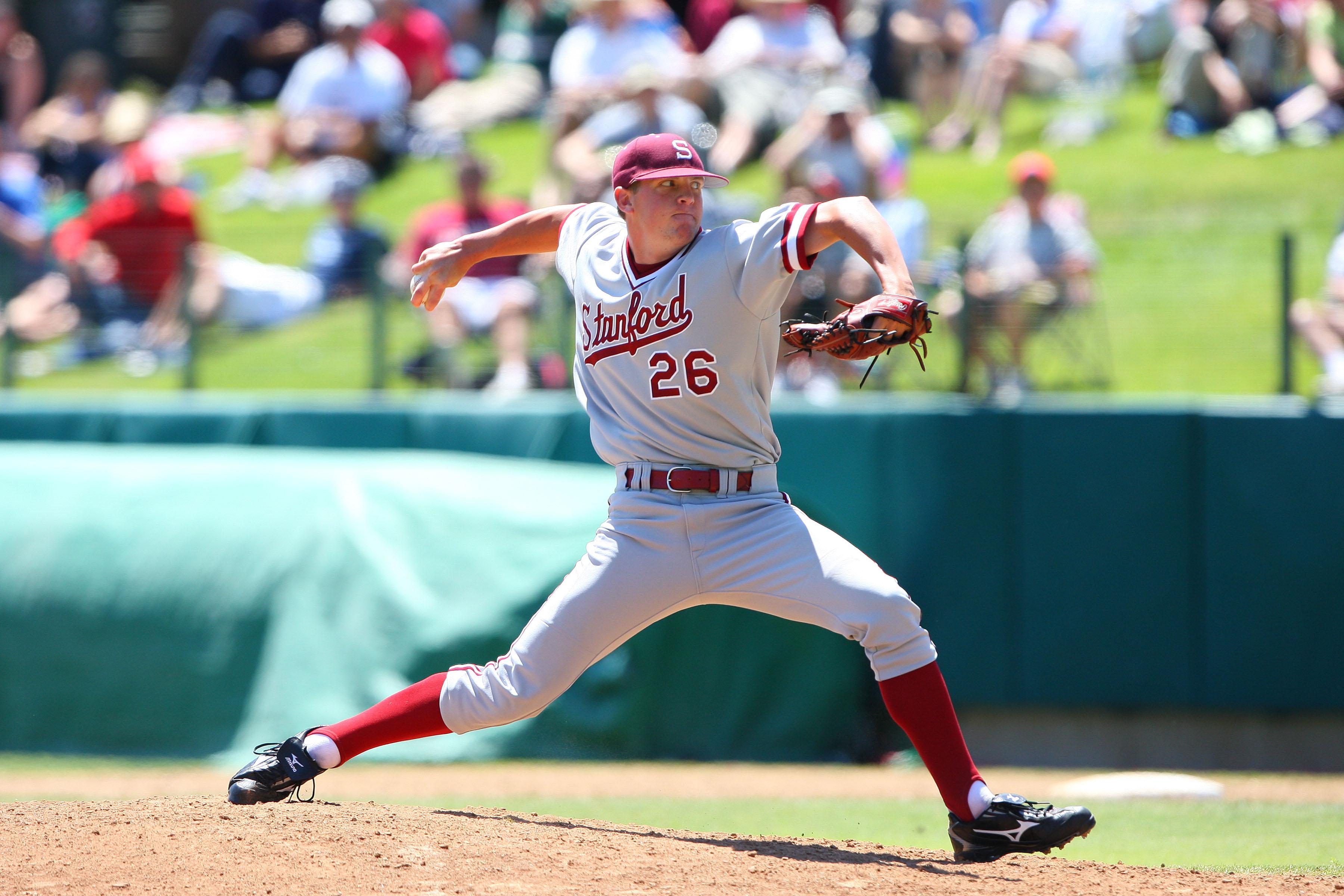
| Touching Bases | June 04, 2009 |
Drew Storen, like me, is a sophomore in college. Unlike me, he is about to become a very wealthy man. Storen is perhaps the top reliever in this year's draft.
Storen, 21, is a rare draft-eligible sophomore who managed to lead Stanford in both wins and saves this year. In 42.2 innings, he went 7-1 with seven saves, and 66 strikeouts compared to just eight walks. In Storen's last appearance of the year, he struck out eight Oregon State batters in 2.2 innings of work while earning a win.
The 6'2", 180-pound right-hander hails from Brownsburg, Indiana. Storen's father, Mark Patrick, has also been involved in baseball as until this year he was the host of Baseball This Morning on XM Radio. In high school, Storen garnered Louisville Slugger first-team All-American honors and was the 49th ranked high school prospect by Baseball America. Storen was drafted in the 34th round by the New York Yankees, but failed to sign having already committed to Stanford.
While ESPN's Keith Law reported in his latest mock draft that the Seattle Mariners are considering drafting Storen in the first round as a starter, Law also has noted that Storen could be could be seen in the Majors later this year coming out of the bullpen.
 Jeremy: How does it feel to have just finished up your season and possibly baseball career at Stanford?
Jeremy: How does it feel to have just finished up your season and possibly baseball career at Stanford?
Drew: It’s kind of bittersweet. I’m happy with the year I had, but I wish we were still playing. Last year, competing in the postseason was a priceless experience, and we had a late run at the end of this season, but it didn’t work out. It's kind of frustrating seeing other teams playing now.
Jeremy: How was your experience last year in the College World Series?
Drew: I pitched a lot. I came in to close a couple of times. The super regional was a lot of fun—getting 2 saves there, coming in in big spots, being on TV, having everybody watch—it was a lot of fun. It was great. A year full of hard work that just really paid off. Omaha is tough to describe. It was so awesome. Just in general a lot fun.
Jeremy: Last year you had Jason Castro catching you too. How was that?
Drew: He’s a big leaguer. He’s a professional. He really knew what he was doing, and he did a great job of handling the pitching staff. He knew what we liked to do. He did a great job blocking everything. He'd come out and tell us what we’re doing wrong, like if it was something with our mechanics. I learned a lot from him.
Jeremy: So who calls your pitches?
Drew: The pitching coach calls them, but we have the power to shake, and our catchers have the ability to make a call if they see something in the batter. So all three of us have a say.
Jeremy: In your last appearance on May 23, you struck out eight in 2.2 innings. That's pretty impressive. What makes things click for you?
Drew: You know, I didn’t realize I struck out eight until it was over. It was one of those things where you kind of keep going with it. You don’t think of what’s going on. You’re just in the flow of the game, and you just go pitch by pitch. You just try to win every pitch. I just struck out some guys, and like you said, everything clicks. You're throwing everything where you want it to be, and the ball breaks where it’s supposed to, and it breaks hard.
Jeremy: What statistics do you look at to measure success?
Drew: Strikeout-to-walk ratio.
Jeremy: Definitely.
Drew: Not necessarily because of K’s, but I try to minimize walks. If you’re walking guys, you’re giving up free baserunners. I’d rather have them earn it. But I don’t really look at stats. I usually go off of feel. That's what tells me how I'm pitching.
 Jeremy: How about a scouting report on yourself? What do you throw? What are your strengths and weaknesses? How would you describe your delivery or mechanics?
Jeremy: How about a scouting report on yourself? What do you throw? What are your strengths and weaknesses? How would you describe your delivery or mechanics?
Drew: I attack guys a lot. I throw a hard fastball and two different types of breaking balls. One is what I call a power slurve. It doesn’t have a 12-6 break. It's more a 2-7:30 break if you're looking at a clock. It's 81-83. Then I throw a true slider that's 87-89. I throw a change, but not in a relief role. I throw a lot of strikes. My command got a little stronger this year. My fastball is in the zone even when I get hit. That’s what happens when you throw strikes. I'm not one of those guys who's going to be effectively wild. I don’t walk guys. I leave the ball up in the zone sometimes and pay for it. But I always try to jump ahead of guys and make them bite on a ball out of the zone when I get ahead.
Jeremy: You had just that one bad outing all year against Arizona State. Was that just an off-day or were you having a problem you've been able to diagnose?
Drew: It was just one of those days. Things didn’t go my way, and I paid for it. I had great stuff that day and didn’t have things fall my way. You’ll have those days. It was a big learning experience for me. It was a midseason slap in the face. But it's all about how you come back from that stuff. It's easy to just fold your stuff up and mail it in for the rest of the season, but I wanted to get back on the mound the next day. You’re not going to go out there and throw well every time, so you have to take those days as learning experiences.
Jeremy: Do you model your game after anyone?
Drew: Out of the pen, I really like the way K-Rod throws. He comes out and is an offensive pitcher. You get the feeling hitters are uncomfortable in the box. He’s attacking guys. Papelbon is the same way—high intensity, electric. Mariano because he’s very professional, like I've done this before, I've done it hundreds of thousands of times before.
Jeremy: Are you like K-Rod and Papelbon in that you show your emotions on the mound or like Mo in that you keep a cool demeanor?
Drew: When I’m pitching, I did one fist pump all year. That was after the eight strikeouts. I don’t do the real emotional thing when I’m done, but when I’m throwing I have the intensity of Papelbon and K-Rod. But once I’m done, I don’t do the extreme celebrations.
Jeremy: What do you feel goes into a closer’s makeup? Do some people just have it? Is there a certain mentality?
Drew: I think that is the case. I don’t think people just have it, but I think some don’t understand what you need to use in that role. As a closer you have to go pitch by pitch. You minimize the game and just think you have to win each pitch regardless of the score. On a bigger level, you need to get each guy out. It's not necessarily that people have a mentality, but people think too much. People put weight into how many guys are on base, and not focused on what they need to focus on. It's important to have a short memory, You don’t want to get too high off a good outing or too low off a bad one. You need the mentality that if you give up 7 runs, like I did against Arizona State, you want to get back on the mound the next day. You have to be able to forget about that stuff.
Jeremy: As a reliever, do you think you can have a quick path to the Majors?
Drew: I know that’s an option. Actually, most of the teams I've talked to have said they might want me to be a starter. I try not to assume anything, though. I know I have to work hard to get there.
Jeremy: So are there any differences with you as a starter or reliever?
Drew: I use my change more and my 2-seam fastball a lot more. It has some sink on it. I'll use it out of the pen sometimes to get a groundball. I use more fastballs as a starter. I started in the fall, and ended up going back in the closer role in the spring, since we got a couple freshman starters and coach didn’t want to reinvent the wheel giving us all new roles.
 Jeremy: You mentioned you've talked to teams. Do you have a preference where you go and how have you been handling the rumors?
Jeremy: You mentioned you've talked to teams. Do you have a preference where you go and how have you been handling the rumors?
Drew: I definitely don’t have a preference. I’ve heard a lot of things though. My advisor's been saying a lot, but there's not really a whole lot yet out there. Not everybody has their boards together. It's too early to tell, even though it’s just a week out. I won’t even be able to tell you where I'm going on draft day. It’s tough, I try not to listen to it too much. I don’t get my hopes up. I just take it a day at a time.
Jeremy: Where will you be on draft day?
Drew: I think I’m going to be home in Indiana with my family. I get done with school Sunday night.
Jeremy: Who is your advisor?
Drew: Brodie Van Wagenen with CAA.
Jeremy: And the decision to sign will be more your advisor's decision or your family's?
Drew: It’s going to be my call. It’s going to be me out there getting the job. But I'm going to get advice from everyone.
Jeremy: How was the process of getting drafted by the Yankees in 2007? Did negotiations ever get serious?
Drew: It was great. From the beginning I told them where I was at. Once you get that Stanford tag, a lot of teams don’t even waste their time. I had good relationship with them stemming from my showcase with them junior year. I told them to draft me wherever and see if we can work something out. If I get the right money I’ll go. But it never really got serious. They knew where I stood, and they handled it well. They didn't try to pressure me, and I appreciated that.
Jeremy: As a sophomore, will that affect negotiations?
Drew: Well, I’m going to want the rest of school paid for, but negotiations-wise I wouldn’t say anything is much different. The biggest thing as a sophomore is that a lot of times, teams get scared off. But you try not to scare off teams, I don’t think it’s much of a problem.
Jeremy: What else? You were in the Cape Cod League last year. How was that?
Drew: It was great. It was an experience on and off the field. There are so many people into those games. It's a great experience. Doing the kids game was fun too. On the baseball side, you kind of learn what pro ball is like playing every day. At one point I think we had 25 games in 25 days. Your body gets worn out. You have to take care of your body day in day out. It's different than college which is Friday, Saturday, Sunday, Tuesday, and sometimes Tuesday Wednesday. It was great. You learn to pitch better. With wood bats, you can throw inside a bit more.
Jeremy: How has this last week been for you? How have you been handling all the interviews and the rumors? Does it get nerve-racking?
Drew: I’m enjoying it, taking it all in. It’s a great experience. It’s not something I’m nervous about. I’m in a win-win situation. Worst case scenario, I get to come back here next year.
Jeremy: Alright, is there anything else you'd like to add?
Drew: Nope. I think that's it.
Jeremy: Thanks for taking the time.
Drew: Thank you.
Baseball Analysts would again like to thank Drew Storen for speaking with us. As well, we'd like to thank Matt Hodson of Stanford athletics for setting up the interview.

Photo Credits
Headshot – David Gonzales/Stanford Athletics
After release – Rob Ericson/Stanford Athletics
In delivery (two) – Kyle Terada/Stanford Athletics
Comments
Nice job, Jeremy. That was a great read.
Posted by: Sully at June 4, 2009 5:13 AM
I second that emotion. Nicely done. Excellent interview accompanied by several good photos. Thanks, Jeremy and Drew.
Posted by: Rich Lederer at June 4, 2009 8:33 AM
Thanks guys.
Posted by: Jeremy Greenhouse at June 4, 2009 9:52 AM